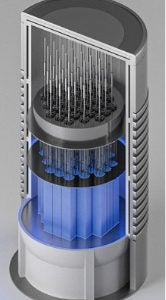Commissioning tests have finally begun at the Angra 2 PWR after a delay of 17 years. The first self-sustaining chain reaction began on July 14. The plant is due to start commercial operation in September.
Angra 2 was built to a Siemens design by German and Brazilian companies, as part of an agreement between the governments of Brazil and Germany. The reference plant for Agra 2 was initially Grafenrheinfeld, a German plant built in 1982, but it has taken so long to build that it also incorporates some of the technology used in Neckarwestheim 2, the youngest nuclear unit in Germany.
Erection of the civil structures for Angra 2 began in 1981, but was slowed down by an economic recession that saw a sharp decline in the demand for electricity in Brazil. At this time, work on a third reactor at Angra was stopped altogether.
Construction on Angra 2 resumed in 1995, when power demand increased in the industrial areas around Rio de Janeiro. There are talks about restarting work on Angra 3. Industrias Nucleares do Brazil (INB), said that the company would not be profitable unless the 1300MW third unit was completed.






